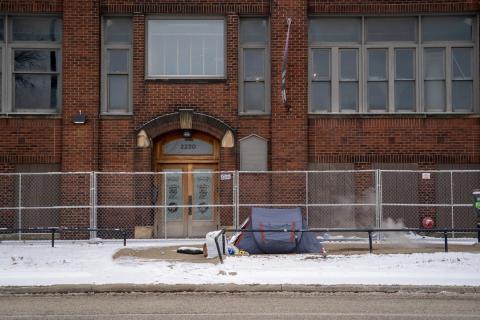Homelessness in Ohio surged last year. Advocates don’t see an end in sight

Listen to this Episode
Ohio housing advocates are predicting a greater number of unhoused people in this year’s annual survey of homelessness.
Many Ohio counties across the state will spend Tuesday evening counting the number of people living in homeless shelters and on the streets. In its annual Point in Time Count (PITC), Ohio tracks the number of people experiencing homelessness in the state on one night in January.
Last year’s count showed increased housing insecurity across the state, according to data recently released by the U.S. Department of Housing and Urban Development. The number of unhoused individuals in Ohio rose by nearly 7% from 2022 to 2023.
Amy Reigel, executive director of the Coalition on Homelessness and Housing in Ohio (COHHIO), said a lack of affordable housing is largely to blame. The state needs 270,000 more units of affordable housing to meet the demand, according to a COHHIO report from last year.
It’s an issue that can’t be, and wasn’t, fixed in just a year, Reigel said.
“There are people who are sleeping under a bridge with the desire, with the dream, to have a front door that they can open and close and lock and have a place to call home, and we are not able to deliver that.”
Pandemic aid ends, rent rises
More than 11,000 Ohioans were homeless during last year’s point in time count.
Reigel said many people were seeing the lingering impact of pandemic-era housing aid, like eviction moratoriums and rent assistance, ending. At the same time, the cost of renting climbed. Average rent for a two bedroom apartment in Ohio increased 18% from 2021 to 2023, according to Reigel.
“You just intensify the impact because you have rising costs and less units, which are just throwing everything out of whack and making it really hard for people to remain stably housed,” she said.

Rising costs didn’t just impact low-income Ohioans. It hurt organizations, like COHHIO, that aim to serve them. Many homeless programs are funded through federal dollars, Reigel said, and their operating budgets aren’t increasing at the same rate as rent.
“We see the number of people that we're seeing increase and the funds that we have to serve them decrease, and that creates a situation where there's just not enough to go around.”
A little bit of hope
Despite the concerning increases, Reigel said Ohio did make some progress in the last year – especially when it came to housing veterans. The number of homeless veterans has decreased by 15% since 2020.
She said it took the collaboration of federal agencies, state agencies and local communities to find success.
“What we see is, when we have those resources available, when people work together and there's coordination between all of these agencies and organizations, that we can make a significant impact on those who experience housing instability,” she said.
Although Ohio saw a sharp rise in homelessness, the surge nationwide was greater. The U.S. saw a 12% increase in homelessness from 2022 to 2023. Reigel said Ohio fared slightly better because many leaders and organizations across the state have been investing in solutions and building a system of resources.
“Ohio has been very effective at bringing federal resources to bear, to build permanent supportive housing, to open shelters and to provide long term assistance to individuals who face housing instability,” Reigel said.
But, Reigel said that system will still need a lot more support to address the current housing crisis.
9(MDYwODMwNTczMDE2ODk5NTExNDAyNzM5Ng000))
- Home
- Schedules
- TV
- TV
- Local TV Programs
- Business | Life 360 with Kristi K.
- Toledo Stories
- To The Point with Doni Miller
- Listening with Keith Burris
- Ideas & Insights
- WGTE Presents
- BL360: Northwest Ohio Innovation Consortium
- Magic of the Old West End
- Freedom Means Never Surrender
- I&I: The Random Factor
- FF: National Cherry Festival
- TTP: Moms Demand Action For Gun Sense in America
- Watch Live
- Radio
- Education
- Community
- Support
- About
- Donate
- Watch Live


